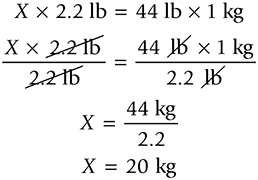Children's fluid needs are proportionally greater than those of adults, and so children are more vulnerable to changes in fluid and electrolyte balance. Because their extracellular fluid has a higher percentage of water, children's fluid exchange rates are two to three times greater than those of adults, leaving them more susceptible to dehydration.

Determining and meeting the fluid needs of children are important nursing responsibilities. You can calculate the number of milliliters of fluid a child needs based on:
Although results may vary slightly, all three methods are appropriate. Keep in mind that fluid replacement can also be affected by clinical conditions that cause fluid retention or loss. Children with these conditions should receive fluids based on their individual needs.
You may use three different formulas to calculate a child's fluid needs based on his weight.
Formula for Daily IV Fluid Calculations:
100 mL/kg for first 10 kg of body weight
50 mL/kg for the next 10 kg of body weight
20 mL/kg remaining kg of body weight
Fluid formula for tiny tots
A child who weighs less than 10 kg requires 100 mL of fluid per kilogram of body weight. To determine this child's fluid needs, first convert his weight from pounds to kilograms. Then multiply the results by 100 mL/kg/day.
Here's the formula:

Fluid formula for middleweights
A child weighing 10 to 20 kg requires 1,000 mL of fluid per day for the first 10 kg plus 50 mL for every kilogram over 10. To determine this child's fluid needs, follow these steps:
Convert his weight from pounds to kilograms.
Subtract 10 kg from the child's total weight, and then multiply the result by 50 mL/kg/day to find the child's additional fluid needs.
Here's the formula:

Add the additional daily fluid need to the 1,000 mL/day required for the first 10 kg. The total is the child's daily fluid requirement:


Fluid formula for bigger kids
A child weighing more than 20 kg requires 1,500 mL of fluid for the first 20 kg plus 20 mL for each additional kilogram. To determine this child's fluid needs, follow these steps:
Convert the child's weight from pounds to kilograms.
Subtract 20 kg from the child's total weight, and then multiply the result by 20 mL/kg to find the child's additional fluid need.
Here's the formula:

Because the child needs 1,500 mL of fluid per day for the first 20 kg, add the additional fluid need to 1,500 mL. The total is the child's daily fluid requirement:

Use this information to solve the following problem.
Finding a fluid solution
How much fluid should you give a 44-lb patient over 24 hours to meet his maintenance needs?
First, convert 44 lb to kilograms by setting up a proportion with fractions. (Remember that 1 kg equals 2.2 lb.)

Cross-multiply the fractions, and then solve for X by dividing both sides of the equation by 2.2 lb and cancelling units that appear in both the numerator and denominator:

The child weighs 20 kg. Now, subtract 10 kg from the child's weight, and multiply the result by 50 mL/kg/day to find the child's additional fluid need:

Next, add the additional fluid need to the 1,000 mL/day required for the first 10 kg (because the child weighs between 10 and 20 kg).

The child should receive 1,500 mL of fluid in 24 hours to meet his fluid maintenance needs. By dividing 1,500 mL by 24 hours, the nurse will set the IV pump at 62.5 mL per hour.

You can calculate fluid needs based on calories because water is necessary for metabolism. A child should receive 120 mL of fluid for every 100 kilocalories (kcal) of metabolism, also commonly called calories.
Fluids help burn calories
To calculate fluid requirements based on calorie requirements, follow these steps:
Find the child's calorie requirements. You can take this information from a table of recommended dietary allowances for children, or you can have a dietitian calculate it.
Divide the calorie requirements by 100 kcal because fluid requirements are determined for every 100 calories.
Multiply the results by 120 mL, the amount of fluid required for every 100 kcal. Here's the formula:

Use the information above to solve the following problem.

Calorie-conscious problem
Your pediatric patient uses 900 calories/day. What are his daily fluid requirements?
Set up the formula, inserting the appropriate numbers and substituting X for the unknown amount of fluid:

The patient needs 1,080 mL of fluid per day.
Another method for determining pediatric maintenance fluid requirements is based on the child's BSA. To calculate the daily fluid needs of a child who isn't dehydrated, multiply the BSA by 1,500, as shown in this formula:

Use this formula to solve the following problem.
BSA-based problem
Your patient is 36" tall and weighs 40 lb (18.1 kg). If his BSA is 0.72 m2, how much fluid does he need each day?
Set up the equation, inserting the appropriate numbers and substituting X for the unknown amount of fluid. Then solve for X:

The child needs 1,080 mL of fluid per day.
Use your calculation skills to solve the following pediatric dosage problem.

An ampicillin answer
The doctor orders a single dose of 360 mg of ampicillin for an infant who weighs 8 lb. Your pediatric drug hand book states that the usual (recommended) ampicillin dose is 100 mg/kg/dose. After reconstituting with sterile water, the ampicillin is available in a concentration of 500 mg/5 mL. Is the dose ordered correct for the patient? What volume of ampicillin should you administer to the infant?
First, you'll need to determine whether the dose ordered is correct.
Set up the proportion to determine the child's weight in kilograms. Remember that 1 kg = 2.2 lb:

Cross-multiply the fractions:

Solve for X by dividing both sides of the equation by 2.2 lb and cancelling units that appear in both the numerator and denominator:

The infant weighs 3.63 kg, rounded off to 3.6 kg.
Next, set up a proportion with the recommended dosage (from the pediatric drug reference) in one fraction and the unknown dosage and the patient's weight in the other fraction:

Cross-multiply the fractions:

Solve for X by dividing each side of the equation by 1 kg/dose and cancelling units that appear in both the numerator and denominator:

So, the doctor's order was correct: 100 mg/kg/dose for a child who weighs 8 lb (or 3.6 kg) is 360 mg.
Next, determine the volume of drug you should administer to the infant.

Set up a proportion with the known concentration in one fraction and the desired dose and unknown volume in the other fraction:

Cross-multiply the fractions:

Solve for X by dividing both sides of the equation by 500 mg and cancelling units that appear in both the numerator and denominator:

You should administer 3.6 mL of reconstituted ampicillin to give the patient 360 mg.

Outline
